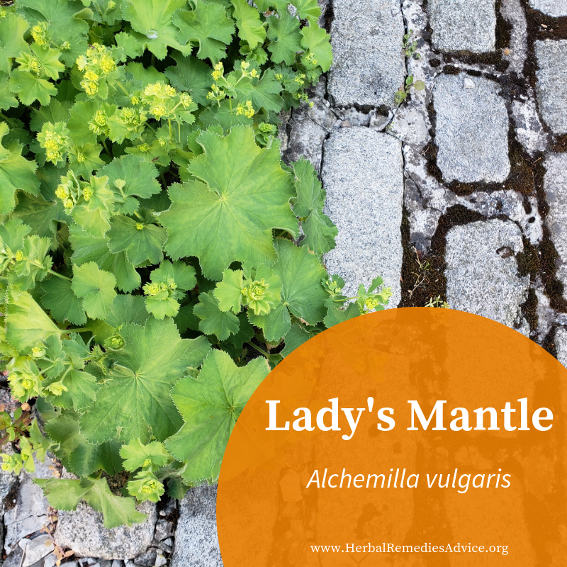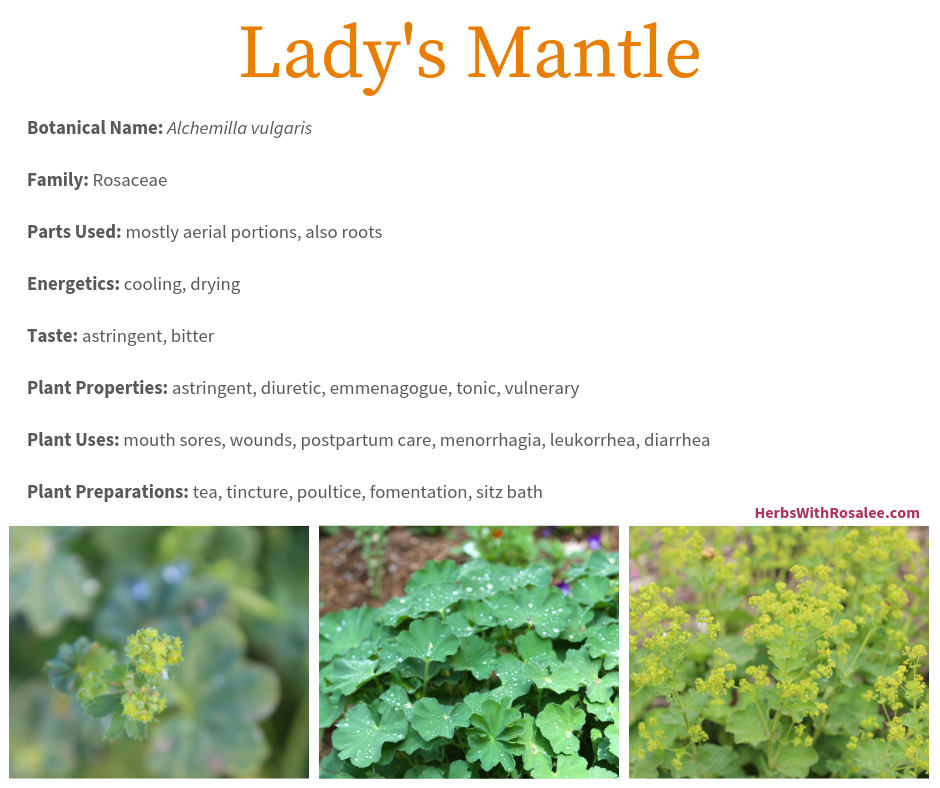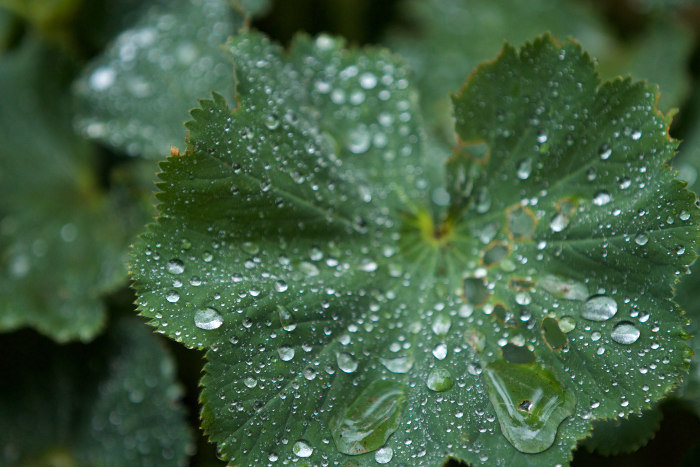Get weekly tips, recipes, and my Herbal Jumpstart e-course! Sign up for free today.

Alchemilla Vulgaris
Share this! |
|
As the sun rises, before the day’s dew has evaporated, you’ll find a special gift cradled within the leaves of Alchemilla vulgaris, or lady’s mantle. The soft furry leaves delicately collect moisture, which then forms ethereal silver droplets; a simple and beautiful sight to behold. This alone is enough of a reason to grow this easy-to-cultivate plant, but there are many reasons beyond its unique beauty to grow lady’s mantle.
Lady’s mantle historically was used to heal wounds, staunch bleeding, and address a wide range of issues, especially in relation to excess discharges. Nowadays, lady’s mantle is an underutilized plant that deserves more of the spotlight.
Alchemilla vulgaris as an Astringent
Lady’s mantle is high in tannins, giving it a moderate degree of astringency. Astringent herbs are used to tighten and tone lax, leaking, or swollen tissues. This action can be used to heal wounds or stop excessive discharges. Many plants within the Rosaceae family are used as general astringents; however, each plant has its own special affinities. For example, wild rose (Rosa spp.) is often used for tonifying the spiritual and emotional heart, while blackberry root (Rubus spp.) is commonly used for astringing diarrhea.
Lady’s mantle has been historically used for many of the general astringent situations you’d expect. The German Commission E has approved lady’s mantle for “light and non-specific diarrhea.”1 But lady’s mantle has also had a long tradition of specific use for problems with menstruation and postpartum care.
Lady’s mantle traditionally is harvested when the plant is in flower, but a study interestingly showed that the plant is higher in tannins when harvested later in the season.2
Alchemilla vulgaris for Healing Wounds (Including Canker Sores)
Native to Europe, there are several historic references to the use of lady’s mantle as an herb for wounds. Nicolas Culpepper (1616-1654) wrote that lady’s mantle was “highly prized and praised” as “one of the most singular wound herbs.” He describes it as being used to dry up wounds, relieve inflammation, and even address infected wounds.3
A study published in March of 2019 confirmed the historic use of lady’s mantle as a wound healer. In this in vitro and in vivo study, lady’s mantle was shown to accelerate the wound-healing process.4
An older clinical study showed that lady’s mantle extracted with glycerin was highly effective at healing the mouth sores known as canker sores or aphthous stomatitis.5
Alchemilla vulgaris for Toning the Uterus and Breasts
Lady’s mantle is most commonly used today for all matters relating to lax tissues in the uterus and vaginal mucous membranes, especially in regard to excessive discharges.
Here are some examples:
- to staunch excessive menstrual flow or regulate menstrual cycles (menorrhagia/metrorrhagia);
- to relieve menstrual pain;
- to address excessive vaginal discharge (leukorrhea);
- to address fibroids and endometriosis.6,7
In addition to stopping an excessive menstrual flow, lady’s mantle is also an emmenagogue, helping to stimulate blood flow to the uterus and promote timely menstruation. This ability to both increase circulation as well as stop excessive flows is a poignant reminder that herbs don’t operate within a world of black and white actions but act in very complex ways.
Lady’s mantle is also used to promote fertility. It is often combined with other herbs like red raspberry leaves (Rubus idaeus), red clover (Trifolium pratense), and stinging nettle (Urtica dioica).
Herbalist Gail Faith Edwards shares that lady’s mantle is a “valuable ally for women dealing with breasts that are lumpy, swollen, or achy before menstruation.” She recommends using it as a tea, wash, or poultice.8 Elizabeth Blackwell (1707-1758), who was a Scottish botanical illustrator and author of The Curious Herbal, wrote, “The leaves applied outwardly are accounted good for lank flagging breasts to bring them to a greater firmness.”
In addition to helping tone tissues, Deborah Francis, RN, ND, also recommends lady’s mantle for emotional support. In her presentation notes for the 2013 Medicines of the Earth Conference, she says, “[lady’s mantle] is also indicated for trauma, emotional or physical, and should be considered after miscarriage, abortion, surgery, ruptured ovarian cyst, or pelvic inflammatory disease.”
Alchemilla vulgaris for Postpartum Care
Lady’s mantle has many virtues for postpartum care, whether for general recovery and health or for more specific reasons. It can be considered (in addition to medical care) for any type of prolapse. I commonly recommend it as a sitz bath for tears during labor, hemorrhoids, or general postpartum healing, in which case I often combine it with plantain (Plantago spp.), yarrow (Achillea millefolium), and calendula (Calendula officinalis).
Lady’s mantle was historically used for postpartum hemorrhage; however, as herbalist and doula Leslie Lekos points out, this is a potentially serious situation and medical care should be immediately obtained.
Leslie Lekos also shares, “This plant really shines during the postpartum time period. Most notably, in my work as a doula and with lactation support I have recommended this herb to women who have expressed disappointment with the tone of their breasts after lactation. After several weeks of applying daily compresses of strong lady’s mantle tea and drinking the tea or taking a tincture daily, several women have expressed satisfaction with the results.”9
Alchemilla vulgaris for Supporting Menopause
Lady’s mantle can be of general use to support the transition through menopause. A survey of British herbal practitioners showed that nearly 39% use lady’s mantle for menopause.10 In her book The Gift of Healing Herbs, herbalist Robin Rose Bennett recommends it specifically for excessive menopausal bleeding.
Alchemilla vulgaris, Botanically Speaking
Lady’s mantle is an herbaceous perennial native to Europe. There are over 300 species within the Alchemilla genus. While some of those species may be used similarly to A. vulgaris, more research needs to be done to show if other species are useful in similar ways.
Lady’s mantle thrives in shady settings with moist soils and can tolerate some sun or dry conditions. This is a very easy plant to grow and is often one of the first plants to appear in my northern garden. The plant grows in clumps, first near to the ground; as the plant flowers, it reaches 1-2 feet in height.
The leaves are a distinctive semi-circular shape, scalloped, toothed, and creased like a lady’s fan. They are soft due to the downy hairs on the plant.
The flowers are quite small and are yellowish green. They grow in clusters that rise above the leaves and are often used in early spring flower arrangements.
Alchemilla vulgaris Plant Preparations
Lady’s mantle can be used as a tea, tincture, poultice, sitz bath, or wash.
Dosage Suggestions:
Tea: 5-15 grams dried leaves and flowers per day
Tincture (fresh plant): 1:2, 40%, 3-5 mLs, three times a day
Special Considerations for Alchemilla vulgaris
Lady’s mantle is considered to be a safe plant for all users.
Citations for Alchemilla vulgaris
Click to show/hide.
Rosalee is an herbalist and author of the bestselling book Alchemy of Herbs: Transform Everyday Ingredients Into Foods & Remedies That Healand co-author of the bestselling book Wild Remedies: How to Forage Healing Foods and Craft Your Own Herbal Medicine. She's a registered herbalist with the American Herbalist Guild and has taught thousands of students through her online courses. Read about how Rosalee went from having a terminal illness to being a bestselling author in her full story here.



